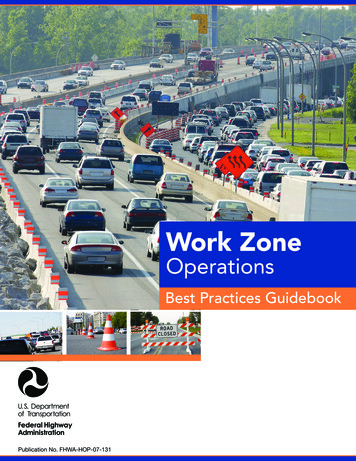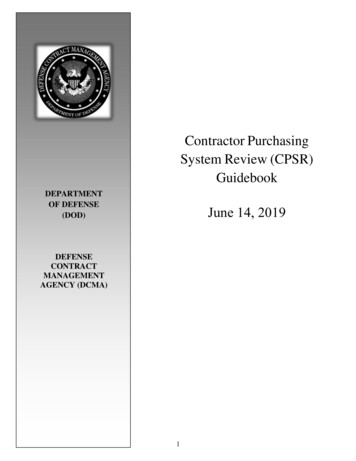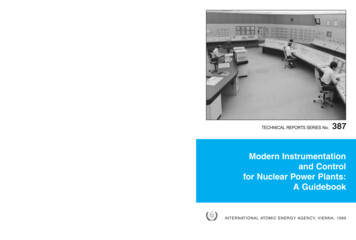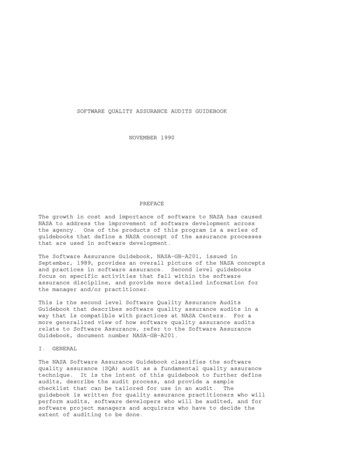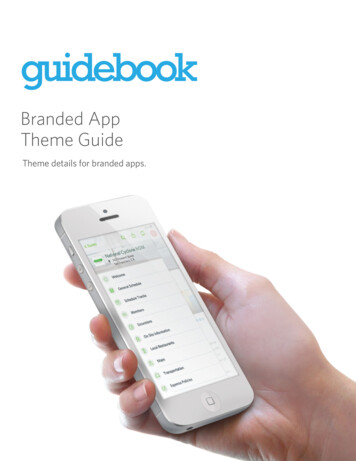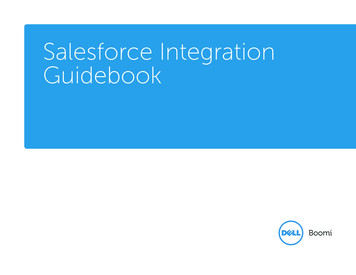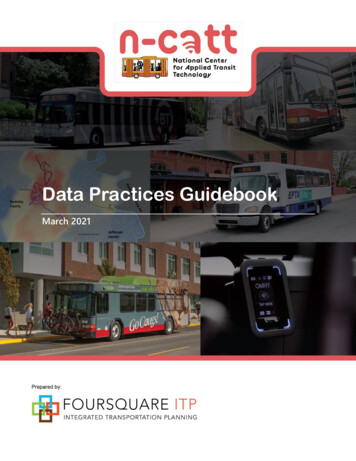
Transcription
Data Practices GuidebookMarch 2021
Data Practices GuidebookCONTENTSExecutive Summary . 1Types of Data Practices . 2Profiled Data Practices . 4List of Abbreviations . 5Introduction . 7Navigating This Guidebook . 8About N-CATT . 9About This Document . 9Section I: What exactly do we mean by "Data?" . 101. Data Sources . 111.1. Introduction . 131.2. State of the Practice . 151.2.1. Manual Data Sources . 151.2.2. Passive Data Sources . 21Agency Profile: Frederick TransIT Technology Adoption . 231.3. Emerging Advancements . 251.4. Conclusion . 262. Data Standards. 292.1. Introduction . 302.2. State of the Practice . 302.2.1. GTFS Schedule Data . 30Agency Profile: Crawford Area Transportation Authority Use of the RTAP GTFS Builder . 322.2.2. Real-Time Arrivals . 362.2.3. Transit Asset Management Data . 372.2.4. Ridership Data . 382.2.5. Internal Standards . 392.3.Emerging Advances . 412.3.1. GTFS-Flex . 412.3.2. GTFS Validators . 442.3.3. Intelligent Transportation Systems (ITS) Standards. 442.3.4. Demand-Response Transit Transactional Data Specifications . 452.4. Conclusion . 463. Open Data . 483.1. Introduction . 493.2. State of the Practice . 493.2.1. Benefits of Open Transit Data . 503.2.2. Publishing Open Transit Data . 513.2.3. Using Open Data . 563.3.Emerging Advances . 593.3.1. Web Tools to Obtain and Visualize External Open Data . 593.3.2. New Data Sources . 62i
Data Practices Guidebook3.4. Conclusion . 62Section II: What exactly do we mean by "Using Data?" . 644. Planning and Performance Monitoring . 654.1. Introduction . 664.2. Planning . 664.2.1. Ridership Analysis . 674.2.2. Market Analysis. 714.3.Performance Monitoring . 744.3.1. Ridership Data . 754.3.2. Schedule Performance Data . 774.3.3. Financial Data . 784.4. Conclusion . 805. Partnerships . 835.1. Introduction . 855.2. Partnerships Providing Access to Data . 855.3. Partnerships for Data Analysis and Technology . 90Agency Profile: Eastern Panhandle Transit Authority and Berkeley County, WV “Where’s My Bus”Application . 925.4. Using Data to Build Partnerships . 955.5. Conclusion . 976. Access and Equity . 996.1. Introduction .1006.2. Practices to Increase Access and Equity with Data .1006.2.1. Service Equity Analysis .1016.2.2. Accessibility Analysis .1036.2.3. Fare Equity Analysis .1056.2.4. Customer Profiles .1066.2.5. Trip Purpose Analysis .1076.2.6. Trip Planning Accessibility .109Agency Profile: Pullman Transit Mobile App .110Agency Profile: Blacksburg Transit Mobile App.1136.3. Conclusion .115Key Themes .117Additional Considerations for Decision-Making .118References .119Appendix – List of Interviewees .123FIGURESFigure 1: Cycle of Data Use to Solve Problems and Improve Services . 7Figure 2: Manual Ridecheck Form . 15Figure 3: EPC Device Example . 16Figure 4: Trip Request and Trip Log Process . 17ii
Data Practices GuidebookFigure 5: MTA Maryland Rate My Ride Customer Service Feedback Interface . 19Figure 6: Cutout of the Pulaski Area Transit Customer Survey . 20Figure 7: AFC Systems . 22Figure 8: TransIT Mobile Fare Payment App . 23Figure 9. Example of Location-Based Services Data in Montana . 26Figure 10: The RTAP GTFS Builder in Use . 33Figure 11: Routing Options . 34Figure 12: Manteca Transit’s NextBus App . 37Figure 13: Example TAM Spreadsheet, Akron METRO Bus. 38Figure 14: Example Trip Planner Using GTFS-Flex, NWConnector . 41Figure 15: TCaT’s Trip Planner Powered by GTFS-Flex . 42Figure 16: VTrans Statewide Trip Planner . 43Figure 17: Transit Data Types and Sharing Characteristics. 52Figure 18: Methods for Sharing Data Online . 54Figure 19: Census Reporter Interface Showing Tahlequah, OK . 59Figure 20: Policy Map Interface Showing Hospital Locations . 60Figure 21: OnTheMap Interface Showing Employment in Cherokee County, Oklahoma . 60Figure 22: CTPP Data Viewer . 61Figure 23: Cycle of Planning and Performance Monitoring . 66Figure 24: Average Total Boardings by Trip, Muskegon Area Transit System (MATS) Route 251 . 69Figure 25: Boardings and Alightings by Stop, MATS Route 251, Pick-Up Locations in Pulaski, VA . 69Figure 26: Jobs and Population Density, Harrisonburg, VA . 72Figure 27: Travel Flows in Battle Creek, MI from a Regional Travel Demand Model . 73Figure 28: Example of Passenger Loads and Seated Capacity on a Fictional “Blue” Route . 76Figure 29: Pulaski Proposed Fixed-Route Network. 76Figure 30: An EPTA Van in Service. 93Figure 31: Where’s My Bus Webpage . 93Figure 32: Where’s My Bus Mobile App . 94Figure 33. Example Map of Minority (Non-Hispanic) Populations for Service Equity Analysis .102Figure 34: Mapnificent in Little Rock, AR .104Figure 35: Minneapolis’s Job Accessibility Map .105Figure 36: Example Survey Language on Trip Purpose .107Figure 37: Champaign-Urbana Mass Transit District (MTD) Trip Planner .109Figure 38: VVTA's New Solar-Powered, Real-Time Sign.110Figure 39: A Pullman Transit Bus in Operation .110Figure 40: Vehicle 307’s Routing and Current Load .111Figure 41: Pullman Transit’s Mobile App .111Figure 42: BT Sign with Stop ID .113Figure 43: BT Mobile App .114TABLESTable 1: Manual and Passive Data Collection Characteristics . 14iii
Data Practices GuidebookTable 2: Required and Optional GTFS Files . 31Table 3: Data-Driven Service Planning Methods. 67Table 4: Data-Driven Performance Monitoring Methods . 74Table 5: Summary of Partnerships that Provide Access to Data . 85Table 6: Summary of Partnerships on Technology . 91Table 7: Summary of Ways to Use Data to Strengthen Partnerships . 95Table 8: Access and Equity Analyses.100iv
Data Practices GuidebookEXECUTIVE SUMMARYThe National Center for Applied Transit Technology(N-CATT) is a technical assistance center with a missionto provide small urban, rural, and tribal transit agencieswith practical resources that help them apply technologicalsolutions and innovations. To this end, N-CATT presentsthe Data Practices Guidebook, a resource for agenciesseeking actionable insights from data. Beginning with anData Practice s collect,structure, or analyzedata to improve agencyoperations and howtransit riders are served.overview of how agencies can obtain more and betterdata, the Guidebook addresses the state of the practiceand emerging trends in data collection, management, and the use of open data. On this foundation, theData Practices Guidebook then guides agencies on how to use data through the lenses of planning andperformance monitoring, partnerships, and access and equity.The data practices featured in this Guidebook are tailored to small urban, rural, and tribal agencies. Whilethe discussion of these practices is drawn from experiences at such agencies, some emerging datapractices are found primarily at transit providers in major metropolitan areas. This Guidebook seeks toprovide smaller agencies with both an understanding of the range of current practices, as well as othersthat may become more widespread in the coming years. Transit managers and planners using thisGuidebook can use the prompts and checklists provided to consider current and emerging data practicesthat may be well-suited to your agency.1
Data Practices GuidebookTypes of Data PracticesPractices for Obtaining DataFor transit agencies, making good use of data begins with identifying, collecting, and storing the datasources your agency may already have—and in some cases, accessing useful data for planning fromexternal sources. This data may be manually collected or represent digitized paper records, butincreasingly agencies rely on passive, sensor-based systems to automatically harvest large quantities ofdata. With raw data in hand, a best practice is to use common data standards to format and managedata. Doing so paves the way for quicker analyses or allows for broader dissemination of data tocustomers and stakeholders. Whether publishing data or making use of open sources like the USCensus, transit agencies stand to benefit from participating in the broader open data ecosystem.Ma nua l D a ta S o ur c esPa ssiv e D a ta S o ur c esFor some agencies, digitizing existing records or simplycollecting more data manually will be the first priority whenworking with data. Such data includes ridechecks, triprequests, on-board customer surveys, and customer servicecomplaints, as well as internal records on asset condition,safety incident reports, and maintenance data.Passive, or automatic, data sources collect information usingelectronic sensors and are capable of generating large volumesof highly granular data. Although these technologies carry ahigher capital cost than manual data sources, passive sourceshave lower marginal costs as well as increased data coverage,availability, and reliability.E mer ging A dva nc es i nD a ta C o llec tio nE xisti ng D a ta S ta nda r dsWhile sensor-based, passively generated data is increasinglypart of the state of the practice for transit agencies, emergingtechnological advances are changing how such data isgenerated: from internet-connected parts and systems tocustomer cellphone location data, to the data generated asagencies provide more customized services.Emerging Data StandardsStandards are emerging to provide demand response andother flexible transit services with the same level of visibilityas GTFS provides to fixed-route services. Systematicallyrecording and managing trip history and ridership data arealso set to be improved by emerging standards.Standards can be either formal data standards that areadhered to across the industry or informal data practices thatare defined at each agency. Regardless, standards are a keydeterminant of how much agencies—as well as customers andstakeholders—can get out of data. The General Transit FeedSpecification (GTFS) for both static transit schedules and realtime updates is the most prevalent standard for data used inthe transit industry today.Open DataAs data producers and data users, transit agencies can benefitfrom accessing external open datasets as well as opening theirtransit data. Open data practices lead agencies to promoteservice awareness and transparency, improve efficiencies, spurinnovations, improve customer satisfaction, become moreengaged with customers, and improve service and data quality.2
Data Practices GuidebookPractices for Using DataData-driven planning decisions are the key to maximizing the use of limited resources for the greatestbenefit of transit riders. While the use of data to inform planning and performance monitoring decisions isnot new, the richness of new data sources provides agencies with the ability to conduct more preciseevaluations of performance and to plan services with greater clarity. However, many small agencies donot have the resources to collect or analyze all the data they need to. Partnerships with otherorganizations—whether they be another transit agency, a non-profit, a state agency, a business, or otherentity—can help provide insights, technology, or expertise. Data also provides a means to assess whotransit serves and how well it serves them in richer detail than ever before.Pla nn ingPer f o r ma nc e Mo ni to r ingFor transit service planning, data provides key insights fordecision-makers when designing and evaluating servicechanges. Though some data like ridership and revenuehours will be tabulated by the agency itself, externaldatasets such as population and employment estimateswill play a role in many planning decisions. As serviceschange and fleets age, decisions on future year capitalinvestment needs can also be made on the basis of assetdata.As communities grow, travel behaviors change, and agencyconditions fluctuate, so too do metrics like ridership, on-timeperformance, service efficiency, revenues, and costs. Transitperformance monitoring is the process of reporting a set ofperformance measures repeatedly over time. However, rural,tribal, and small urban agencies structure their performancemonitoring efforts, new data sources provide newopportunities to gauge performance.Pa r tner sh ips Pr o vid ingA c c ess to D a taPa r tner sh ips f o r D a ta A na ly sis a nd Tec hno lo g yNot all data is "open," and not all open data is readilyused. As a result, agencies must rely on otherorganizations to obtain datasets vital to transportationplanning. Both public and private sector entities can bepotential partners, including local school districts,colleges and universities, major employers, metropolitanplanning organizations (MPOs), regional planningagencies (RPAs), municipal departments, state DOTs, andother transit agencies.ITS devices and thorough data analysis come at the cost ofboth capital outlays and staff expertise. Transit agencies neednot conduct all procurement or data analysis themselves:often, there are partners that can help agencies procure,develop, or maintain technology or who can process datasetsthat new technologies produce. In some cases, agencies aresharing their own proprietary technology with other agencypartners.Using D a ta to Bui ld Pa r tner sh ipsUsing D a ta f o r A c c ess a nd E qu it yIt can be difficult for transit agencies to prove theirimportance to the agencies and organizations that fund,oversee, or partner with them. When building a newrelationship with a partner organization, providing proofof the effectiveness of an agency can be even moredifficult. Certain types of data analyses can help illustratea transit agency’s importance to a community and makethe case for more funding support from current andexisting partners.Evaluating accessibility to key destinations and jobs is anemerging trend in the industry. Transit agencies have begunto pay more attention to accessibility metrics, which examinehow well transit provides connections to key destinations.Although equity analysis is required through Title VI, thereare opportunities for agencies to address these questionsmore thoroughly. Equity considerations include serviceoffered, fare payment types, trip purpose analysis, and tripplanning accessibility.3
Data Practices GuidebookProfiled Data PracticesThis Guidebook surveys both the current state of data practices at small transit agencies around thecountry, as well as recent advances in this domain. Following an initial desk review of the transitliterature, notable implementations of data practices by small agencies were selected for more detailedresearch. For these profiled data practices, interviews with transit staff were used to document thecontext and methods of the practice, significant barriers faced, and the outcomes and lessons learnedfollowing implementation.Tec hno lo gy A do p tio n a t Fr eder ic k Tr a nsI TC usto mer Mo b ile A pp a t Pu ll ma n Tr a ns itOver the past several years, TransIT, a small urban agencyin Frederick, Maryland, has implemented a number oftechnology upgrades to improve the passengerexperience, data collection, and data reporting. Theseupgrades included installing automated passengercounters (APC) and automatic vehicle location (AVL)devices on its fixed-route fleet, launching a new mobileticketing app, and purchasing nine fully electric vehicles.Pullman Transit, located in eastern Washington, deployed anew mobile app in 2019 when it updated its AVL system. Themobile app has many capabilities, including real-time vehicletracking, passenger load tracking, a trip planner, automatedannouncements, and the ability to receive feedback. Thefeedback Pullman receives from riders through the app is alsoimportant as it helps identify real-time issues." W her e's My Bus" a t E PTAG TFS C r ea tio n a t C A TAAfter conversations with Bluefield Transit, another smalltransit agency in West Virginia, the Eastern PanhandleTransit Authority (EPTA) learned how they could create areal-time bus location web interface with their AutomaticVehicle Locator (AVL) data. EPTA enlisted the BerkeleyCounty Information Technology (IT) department’s help todevelop a similar interface. The site can be viewed easilyon a mobile phone in addition to EPTA’s website.Crawford County and Venango County, Pennsylvaniaconsolidated their transit services in 2016, with VenangoCounty Transit merging into CATA. The consolidation ofservices required a merging of both agencies’ datasets, whichwere in very different formats. To accurately merge data,create a better inventory of stops, and improve trip planningfor customers, the agency created a GTFS feed using the RuralTransit Assistance Program (RTAP) GTFS Builder and GoogleEarth.Blacksburg Transit Real-Time Bus Location Text ServiceBlacksburg Transit (BT) provides service in Blacksburg and Christiansburg, VA, with much of its service centered on VirginiaTech University. Driven by requests from students for more real-time information, BT partnered with a computer scienceprogram at Virginia Tech to launch a real-time bus location texting service. This service was later turned into a mobile appthat enabled users to see bus locations and passenger loads in real-time, use a trip planner, and receive alerts from BT,among other features.4
Data Practices GuidebookLIST OF ABBREVIATIONSAASHTOAmerican Association of State Highway and Transportation OfficialsACSAmerican Community SurveyAFCAutomatic Fare CollectionAPCAutomatic Passenger CountersAPIApplication Programming InterfaceAVLAutomatic Vehicle LocationBIBusiness IntelligenceBRATSBaldwin Regional Area Transit SystemBTBlacksburg TransitCADCASDComputer-Aided DispatchComputer-Aided Scheduling and DispatchCATACrawford Area Transportation AuthorityCSVComma-separated valuesCTAACommunity Transportation Association of AmericaCTPPCensus Transportation Planning ProductsCUTRCenter for Urban Transportation ResearchDIDisparate ImpactDBDisproportionate BurdenDSTDOTDecision Support ToolsDepartment of TransportationEPTAEastern Panh
the Data Practices Guidebook, a resource for agencies operations and how seeking actionable insights from data. Beginning with an overview of how agencies can obtain more and better transit riders are served. data, the Guidebook addresses the state of the practice and emerging trends
